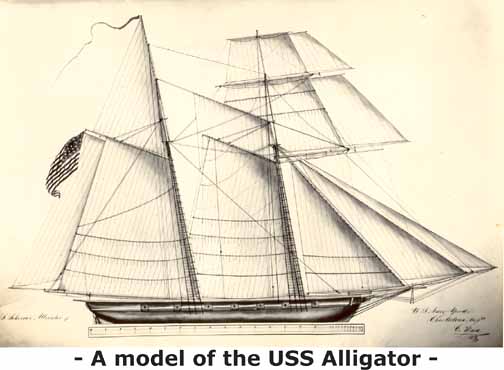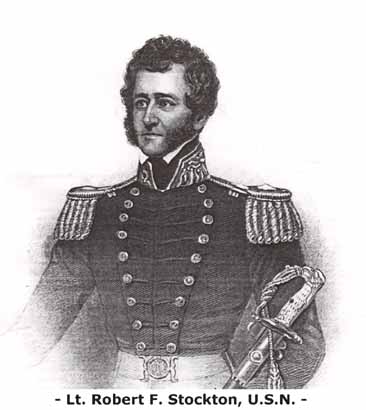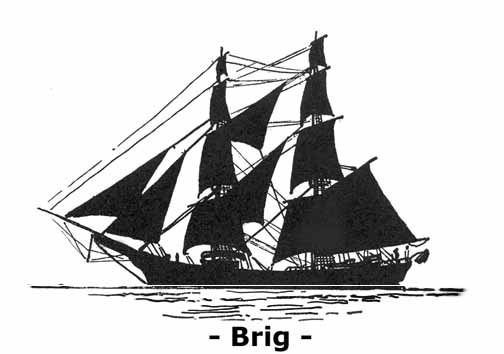-
History of the USS Alligator
-
By Jerry Wilkinson
-
-
-
(All images are thumb nail. Left click to enlarge, then back arrow
to resume reading.)
-
For a introduction
of the topsail schooner, the US Schooner Alligator was 198
tons, 86' length, 24' 7" beam, 10' 4" draft, speed 8 knots, 12 each 6-pound
smooth bore guns. This page uses maritime descriptions of sailing vessels
and two reference pages are provided. For those who are not familiar with
sailing ship's classification, please choose the :
-
To view silhouettes of Early American Sailing Vessels, Click
HERE.
-
To view silhouettes of Early Spanish Sailing Vessels, Click
HERE.
The increasing aggressions of piratical
privateers against American vessels compelled Congress to approve an act
in March 1819 to protect itself. The act authorized President Monroe to
employ a suitable naval force to protect U.S. commerce. In addition, it
authorized for the trial and condemnation of such captures and prescribed
the death penalty for piracy. Through the Congressional Act of March 2,
1807, the importation of slaves into the U.S. was already illegal. Pirates
and slavers in the southern seas became a major problem.
 The USS AIligator's keel was laid 26 June 1820 and was launched
2 November 1820 by the Boston Navy Yard and commissioned in March 1821.
She had a brief but remarkable career. Designed by William Doughty was
the last of the five 12-gun schooners specifically built to combat and
stop pirates and slave traders. Master Commandant R.F. Stockton was placed
in command and she set sail for the west coast of Africa with Dr. Eli Ayres
on board on 3 April. The two were on a mission. Previously, the American
Colonization Society (ACS) had been established in December 1816 in Washington,
D.C. It sought the return of African Negroes to Africa. Among its members
was Henry Clay, Daniel Webster, Thomas Jefferson, John Randolph and other
eminent statesmen. Dr. Eli Ayres of the Alligator was to select
and acquire territory to colonize free men of color in their native continent.
The USS AIligator's keel was laid 26 June 1820 and was launched
2 November 1820 by the Boston Navy Yard and commissioned in March 1821.
She had a brief but remarkable career. Designed by William Doughty was
the last of the five 12-gun schooners specifically built to combat and
stop pirates and slave traders. Master Commandant R.F. Stockton was placed
in command and she set sail for the west coast of Africa with Dr. Eli Ayres
on board on 3 April. The two were on a mission. Previously, the American
Colonization Society (ACS) had been established in December 1816 in Washington,
D.C. It sought the return of African Negroes to Africa. Among its members
was Henry Clay, Daniel Webster, Thomas Jefferson, John Randolph and other
eminent statesmen. Dr. Eli Ayres of the Alligator was to select
and acquire territory to colonize free men of color in their native continent.
 At Cape Mensuado Stockton and Ayres met the local chiefton, King Peter,
and a suitable tract of land was purchased by bartering. This land became
the Republic of Liberia.
At Cape Mensuado Stockton and Ayres met the local chiefton, King Peter,
and a suitable tract of land was purchased by bartering. This land became
the Republic of Liberia.
The Alligator returned
to Boston in July and again set out for Africa on 4 October 1821. The Alligator
engaged
a Portuguese pirate ship, the Marianna Flora, overcame her crew,
captured her and placed a crew aboard her to be taken to the United States.
The Alligator continued her cruise and captured several other slavers
before returning to Boston. Stockton, California is named after him.
In June of 1822 she was assigned
to hunt pirates in the West Indies under the command of Lt. William H.
Allen.
In November, 1822, while the
U. S. schooner Alligator was at anchor in the harbor of Matanzas
on Cuba's northern coast. Lt. Allen was informed by two Americans that
their ships, an American brig, Anna Maria, and schooner had been
captured recently, were lying in a bay 42 miles to the eastward at Guajaba
and being held for $7,000 ransom which they were to bring back. Instead,
the two were outfitting a small schooner, the Ploughboy, in effort
to recover their ships.
The Alligator, its small cutter
and the Ploughboy got under way and the next morning at daylight
anchored near the bay. What they found was a nest of captured American
ships. They could see an American brig, schooner, with three other vessels
at anchor in the harbor. In amongst them was a pirate schooner under sail
and full of men, with boats passing between her and the other vessels.
The Alligator drew about
11-foot of water so being in familiar waters she lowered her armed boats.
Lt. Allen, Captain Freeman with 12 marines prepared for attack. The second-in-command,
Lt. John M. Dale and I I men took the cutter. The Captain of the Ploughboy
and four men even took the Alligator's gig. The wind being light,
the pirate schooner's crew tried to escape with sweeps [long oars]. After
a long chase, the boats came within gunshot. The pirate schooner, identified
as the Revenge, hoisted a red flag and opened fire; the boats prepared
to board. A second pirate schooner then appeared and opened fire on Allen's
boats. The pirates in the Revenge left her in boats, attempting
to get aboard the other schooner. The Alligator's force then tried
to head off the pirate boats, but they returned to the Revenge.
The Americans made another attempt to board the vessel, but her crew again
took to their boats and this time successfully got aboard the other pirate
schooner. The pirates were joined by a third pirate schooner and escaped.
The Americans then took possession of the Revenge while the boats
unsuccessfully chased the other schooners.
All this lasted only about
half an hour and Lt. Allen was wounded twice. The combined pirate crews
on board her numbered about one hundred. The Americans lost two, one being
Lt. Allen, and five wounded. It was learned later that their loss was fourteen
killed and a great number wounded. The Americans brought away their prize,
the Revenge; also the American ship, two brigs, one was the Anna
Maria, and two schooners.
Command of the Alligator passed
to Lt. Dale. Later. Commodore David Porter named the port at Key West "Allenton"
in remembrance of Lt. Allen.
 They knew they were to sail through pirate infested waters and it was rumored
that pirates would follow to capture any vessel that fell behind so they
were to sail in convoy. On the 18th of November the Alligator got
underway from Matanzas, Cuba for Norfolk, Virginia. One of those returning
was the brig Anna Maria under Captain Somers. A brig is a two-masted
square rigged ship and not as fast as the topsail schooner Alligator.
The course was about north which would take them into the Gulf Stream and
northward to Norfolk. Sure enough as the day wore on the Anna Maria and
others fell behind and during the night Lt. Dale turned back and forth
to slow her forward speed.
They knew they were to sail through pirate infested waters and it was rumored
that pirates would follow to capture any vessel that fell behind so they
were to sail in convoy. On the 18th of November the Alligator got
underway from Matanzas, Cuba for Norfolk, Virginia. One of those returning
was the brig Anna Maria under Captain Somers. A brig is a two-masted
square rigged ship and not as fast as the topsail schooner Alligator.
The course was about north which would take them into the Gulf Stream and
northward to Norfolk. Sure enough as the day wore on the Anna Maria and
others fell behind and during the night Lt. Dale turned back and forth
to slow her forward speed.
As morning broke on November
19th only two ships of the convoy could be seen. By four in the afternoon
only the Anna Maria was in sight and she was far to the west or
closer to the reef. Preparing for the night they ordered extra precautions
to remain in the Gulf Stream to avoid the reef to the west. At 9 p.m. the
leadsman found no bottom at 270 feet of water, indicating deep water. Thirty
minutes later the Alligator at about five knots per hour suddenly
grounded herself on the Florida Keys reef.
Lt. Dale quickly surveyed for
damage and the Alligator was basically in good shape. Dale decided
to take an anchor by boat off the stern and using the Alligator's
capstan drag her off the reef. The anchor line broke and she remained hard
and fast grounded. The crew began lightening the ship by throwing heavy
items over board, but the wind shifted to the southeast and blew her farther
upon the reef.
At daybreak, of November 20
they hauled a larger anchor into deep water and heaved-to on the capstan.
The anchor would not catch bottom and they simply reeled in the anchor.
Time after time they failed. At the next high tide, Lt. Dale raised the
sails and tried to drive her across the reef to the other side, but she
remained grounded - so another night on the reef being slowly broken apart.
On the morning of 21 November
a Bahamian wrecking schooner arrived and Lt. Dale began transferring valuable
items to her. In the meantime another sail appeared and by luck it was
the brig Anna Maria. Now the wrecker was not needed and important
items were transferred to the Anna Maria during the day.
Darkness came and still another
night aboard the floundering Alligator. On the morning of the third
day, 22 November, Lt. Dale made a ship's captains choice - the ship could
not be saved. The crew was sent to the Anna Maria and the young
valiant and battle tested Alligator set afire to prevent her from
falling into the hands of pirates. She soon blew up and saying farewell
they set sail in the Anna Maria for Norfolk
The Norfolk newspaper The American
Beacon on December 4, 1822 reported, "Tuesday, Dec. 3. -The brigantine
Ann
Maria, Somers, of New York, from Matanzas, with sugar and molasses,
having on board the officers and crew of the US schr. Alligator,
which was totally lost on the 19th Nov. of Carysfort, on her passage to
this port."
A Court of Inquiry convened
aboard the US Frigate Guerriere on December 13, 1822 exonerated
the crew of the Alligator of negligence.
-
Use Back Arrow to return to reading previous page or:
To return to the Specific Locations and Keys homepage, Click
HERE.
|
The USS AIligator's keel was laid 26 June 1820 and was launched 2 November 1820 by the Boston Navy Yard and commissioned in March 1821. She had a brief but remarkable career. Designed by William Doughty was the last of the five 12-gun schooners specifically built to combat and stop pirates and slave traders. Master Commandant R.F. Stockton was placed in command and she set sail for the west coast of Africa with Dr. Eli Ayres on board on 3 April. The two were on a mission. Previously, the American Colonization Society (ACS) had been established in December 1816 in Washington, D.C. It sought the return of African Negroes to Africa. Among its members was Henry Clay, Daniel Webster, Thomas Jefferson, John Randolph and other eminent statesmen. Dr. Eli Ayres of the Alligator was to select and acquire territory to colonize free men of color in their native continent.
At Cape Mensuado Stockton and Ayres met the local chiefton, King Peter, and a suitable tract of land was purchased by bartering. This land became the Republic of Liberia.
They knew they were to sail through pirate infested waters and it was rumored that pirates would follow to capture any vessel that fell behind so they were to sail in convoy. On the 18th of November the Alligator got underway from Matanzas, Cuba for Norfolk, Virginia. One of those returning was the brig Anna Maria under Captain Somers. A brig is a two-masted square rigged ship and not as fast as the topsail schooner Alligator. The course was about north which would take them into the Gulf Stream and northward to Norfolk. Sure enough as the day wore on the Anna Maria and others fell behind and during the night Lt. Dale turned back and forth to slow her forward speed.
